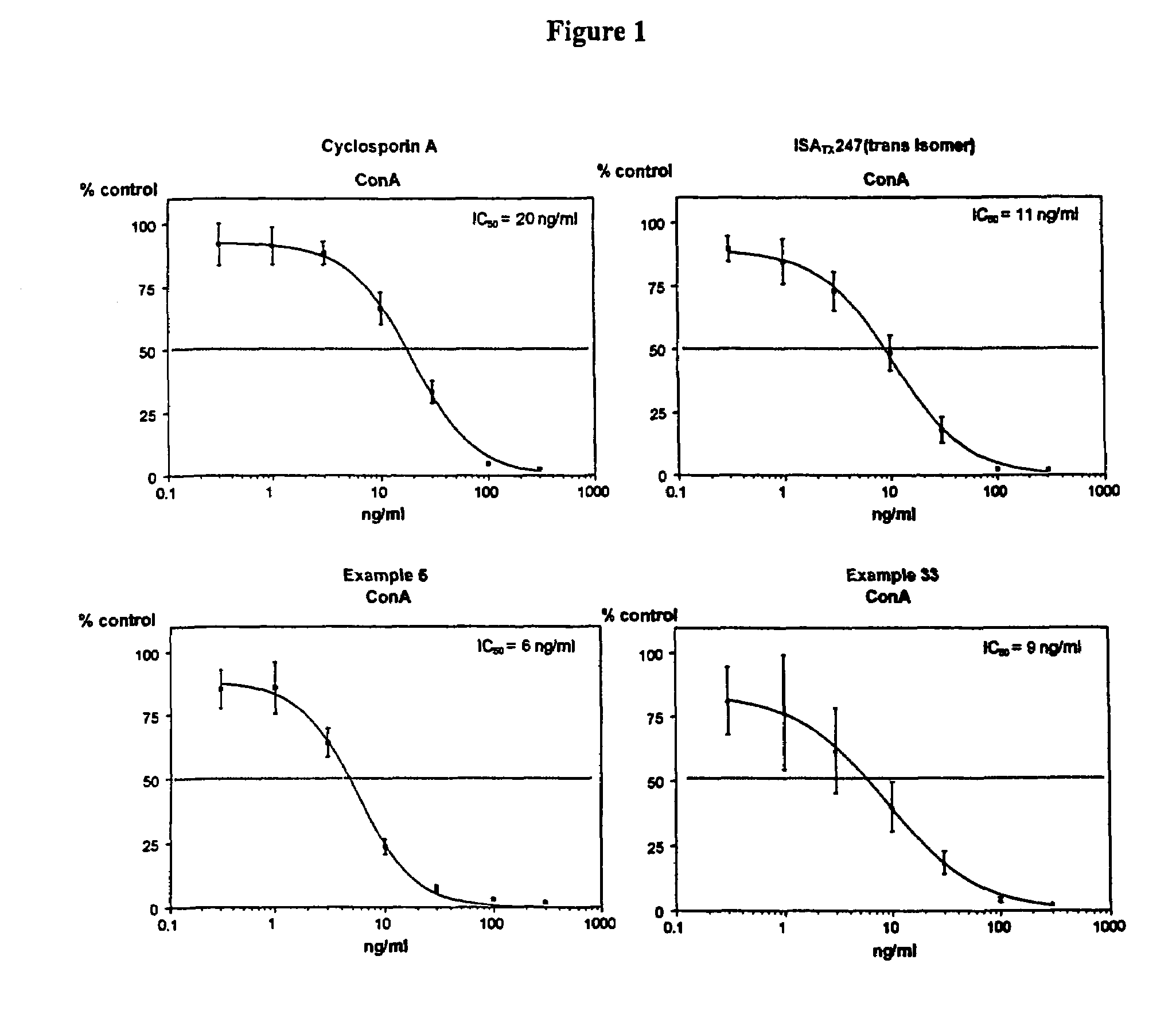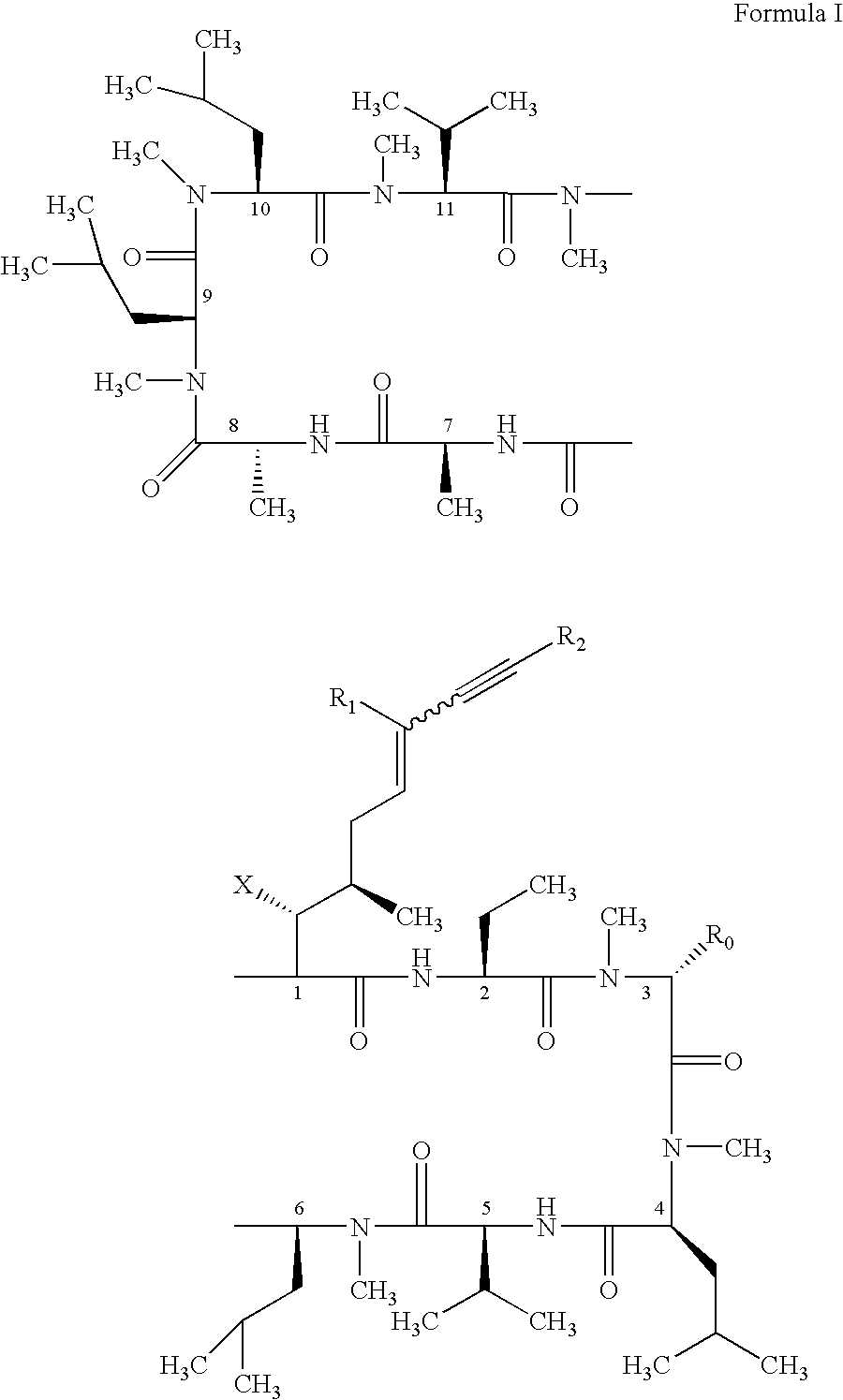Use of cyclosporin alkyne/alkene analogues for preventing or treating viral-induced disorders
a technology of alkene and cyclosporin, which is applied in the field of new drugs, can solve the problems of inability to believe in immunosuppression, inability to show a beneficial effect of treatment, and initial in vivo studies in which cyclosporin a was administered as a monotherapy in hiv-infected patients
- Summary
- Abstract
- Description
- Claims
- Application Information
AI Technical Summary
Benefits of technology
Problems solved by technology
Method used
Image
Examples
example 1
Preparation of Cyclosporin Acetate
[0138]A solution of cyclosporin A (5.0 g, 4.16 mmol), acetic anhydride (7.80 mL, 83.2 mmol), and DMAP (760 mg, 6.2 mmol) in methylene chloride (40 mL) was stirred overnight at room temperature under N2 atmosphere. Saturated sodium bicarbonate solution (200 mL) was added to the solution and stirred for an additional 2 h. The mixture was extracted with ether, washed with 1 N HCl, neutralized with saturated sodium bicarbonate solution, washed with brine, dried over sodium sulfate, and concentrated in vacuo to afford cyclosporin acetate (4.92 g, 95%) as a white solid: 1H NMR (300 MHz, CDCl3) δ 8.57 (d, J=9.6 Hz, 1H), 8.04 (d, J=6.9 Hz, 1H), 7.51 (d, J=9.4 Hz, 1H), 7.47 (d, J=7.8 Hz, 1H), 5.67 (dd, J=11.0, 4.0 Hz, 1H), 5.60-5.44 (m, 2H), 5.39 (dd, J=11.7, 3.7 Hz, 1H), 5.32-5.13 (m, 4H), 5.06-4.93 (m, 2H), 4.85 (t, J=7.2 Hz, 1H), 4.77 (t, J=9.6 Hz, 1H), 4.65 (d, J=13.7 Hz, 1H), 4.41 (t, J=7.0 Hz, 1H), 3.46 (s, 3H), 3.26 (s, 3H), 3.24 (s, 3H), 3.21 (s, 3H)...
example 2
Preparation of Acetyl Cyclosporin Aldehyde
[0139]Ozone was bubbled into a solution of cyclosporin acetate from Example 1 (3.0 g, 2.4 mmol) in methylene chloride (70 mL) at −78° C. until a blue color was developed. The mixture was degassed with nitrogen for a few min and dimethylsulfide (3 mL) was added at −78° C. The reaction mixture was allowed to warm to room temperature and stirred for 3 h. The reaction mixture was concentrated in vacuo and the residue was dissolved in ethyl acetate (300 mL), washed with water (2×70 mL) and brine (70 mL), dried over sodium sulfate, filtered, and concentrated in vacuo to afford acetyl cyclosporin aldehyde (2.79 g, 94%) as a white solid. The crude was carried to the next step without further purification: 1H NMR (300 MHz, CDCl3) δ 9.60 (d, J=3.5 Hz, 1H), 8.55 (d, J=9.7 Hz, 1H), 7.96 (d, J=6.8 Hz, 1H), 7.52 (d, J=7.7 Hz, 1H), 7.46 (d, J=9.0 Hz, 1H), 5.67 (dd, J=11.0, 3.8 Hz, 1H), 5.60-5.45 (m, 2H), 5.32 (dd, J=12.1, 3.3 Hz, 1H), 5.24-5.10 (m, 2H), 5....
example 3
Preparation of Trans Acetyl Cyclosporin Vinyl Iodide
[0140]To an ice-cooled suspension of chromium(II) chloride (1.0 g, 8.2 mmol) in THF (25 mL) was added a solution of acetyl cyclosporin aldehyde from Example 2 (0.50 g, 0.41 mmol) and iodoform (1.29 g, 3.28 mmol) in THF (25 mL). After 7 h at 0° C., the reaction mixture was poured into ice-water (50 mL). The water layer was extracted with ethyl acetate (3×60 mL). The combined organics were dried over anhydrous sodium sulfate and concentrated. The material was purified by semi-preparative HPLC to afford trans acetyl cyclosporin vinyl iodide (290 mg, 52%) as a white solid: 1H NMR (300 MHz, CDCl3) δ 8.47 (d, J=9.8 Hz, 1H), 8.01 (d, J=6.4 Hz, 1H), 7.56 (d, J=8.8 Hz, 1H), 7.54 (d, J=7.5 Hz, 1H), 6.50-6.40 (m, 1H), 5.84 (d, J=14.3 Hz, 1H), 5.69-5.10 (m, 6H), 4.97 (d, J=11.1 Hz, 2H), 4.87-4.73 (m, 2H), 4.64 (d, J=13.8 Hz, 1H), 4.43 (t, J=7.0 Hz, 1H), 3.43 (s, 3H), 3.28 (s, 3H), 3.26 (s, 3H), 3.20 (s, 3H), 3.12 (s, 3H), 2.68 (s, 3H), 2.66 (s...
PUM
| Property | Measurement | Unit |
|---|---|---|
| temperature | aaaaa | aaaaa |
| temperature | aaaaa | aaaaa |
| temperature | aaaaa | aaaaa |
Abstract
Description
Claims
Application Information
 Login to View More
Login to View More - R&D
- Intellectual Property
- Life Sciences
- Materials
- Tech Scout
- Unparalleled Data Quality
- Higher Quality Content
- 60% Fewer Hallucinations
Browse by: Latest US Patents, China's latest patents, Technical Efficacy Thesaurus, Application Domain, Technology Topic, Popular Technical Reports.
© 2025 PatSnap. All rights reserved.Legal|Privacy policy|Modern Slavery Act Transparency Statement|Sitemap|About US| Contact US: help@patsnap.com



